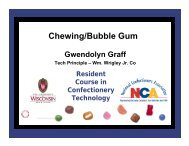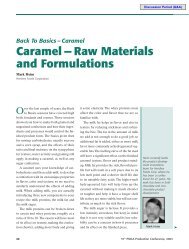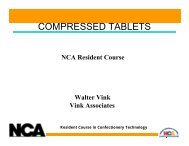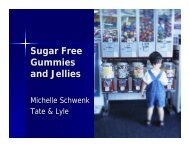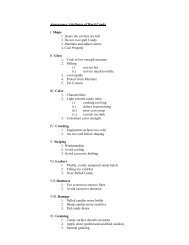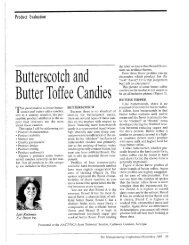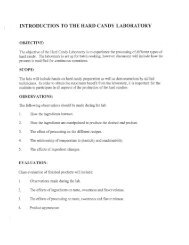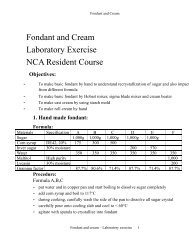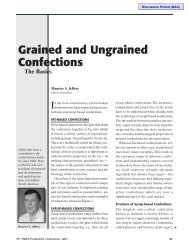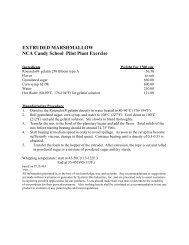2004 Soft Panning - staging.files.cms.plus.com
2004 Soft Panning - staging.files.cms.plus.com
2004 Soft Panning - staging.files.cms.plus.com
You also want an ePaper? Increase the reach of your titles
YUMPU automatically turns print PDFs into web optimized ePapers that Google loves.
<strong>Soft</strong> <strong>Panning</strong><br />
<strong>Soft</strong> panning is<br />
probably the most<br />
challenging<br />
panning process to<br />
move into the<br />
larger automated<br />
pans.<br />
Sugar on Jelly Beans<br />
Dry sugar on surface of<br />
in-process jelly bean<br />
After 5 minutes of run<br />
time, sugar has worked<br />
into surface of in-process<br />
jelly bean<br />
Figure 3<br />
ure 2). Suggested room conditions for soft<br />
panning are temperatures between 60º to<br />
70ºF and relative humidity below 55 percent.<br />
Normally, rotary pans from 36 to 42 inches in<br />
diameter are used for most soft-panned products.These<br />
can be round or tulip shaped and<br />
they are normally stainless steel. However,<br />
for nonacid products, copper pans can be<br />
used. Pans can be ribbed or roughened with<br />
a <strong>com</strong>bination of syrup and sugar prior to<br />
running to assist in tumbling.<br />
<strong>Soft</strong> panning is probably the most challenging<br />
panning process to move into the<br />
larger automated pans. The first reason<br />
that this is such a challenge is due to the<br />
normally tender/soft nature of the typical<br />
center and the fact that some of these<br />
larger pans can have fairly deep bed<br />
depths. In conventional pans, pan speeds<br />
from 20 to 22 rpm seem to be the most<br />
<strong>com</strong>monly used. Since the idea is to attach<br />
the dry charge material with the engrossing<br />
syrup and not to dry and crystallize<br />
the engrossing syrup, drying air is not normally<br />
used. Prepared engrossing syrup is<br />
applied to tumbling centers and allowed<br />
to distribute evenly over the pieces. The<br />
idea is to add a dose of engrossing syrup<br />
that is big enough to wet the entire surface<br />
of the center without gluing the centers<br />
together. The scoops of dry material are<br />
added and allowed to pack onto the surface.<br />
As the tumbling action continues,<br />
the syrup begins to surround the dry powder<br />
and what is typically referred to as<br />
sweatback occurs. This means the surface<br />
appears once again to be moist. More of<br />
the dry charge material is added gradually<br />
until it does not sweat back. Sometimes<br />
it may seem that the end point has<br />
been reached but if the product is allowed<br />
to tumble a little longer the sugar can<br />
work into the surface (Figure 3).<br />
Many factors contribute to the timing of<br />
the dry powder addition and that is the second<br />
challenge for the large, more continu-<br />
ous pans when making soft-panned items.<br />
The <strong>com</strong>bination of one application of syrup<br />
followed by the scoops of dry charge material<br />
needed to dry the surface make up one<br />
layer. Next, another charge of engrossing<br />
syrup is added followed by scoops of dry<br />
material in a similar fashion to the first wetting.<br />
Generally, two to four layers are added<br />
but depending on the thickness of the<br />
desired coat, there can be up to 10 layers<br />
added. Normally, the finer particle size of<br />
dry material is added in the last layer or<br />
layers. This finer material can pack in<br />
between the larger particles and form a<br />
smoother exterior, which will allow for a<br />
more easily polished surface.The last layer<br />
is usually powdered sugar. Product should<br />
be removed to trays to stand overnight to<br />
allow excess moisture to be released to the<br />
air or at least to equilibrate with the center.<br />
If an insufficient amount of powdered<br />
sugar is added to the pieces and sweatback<br />
occurs after the pieces are trayed then the<br />
pieces will have a tendency to stick together<br />
and the coating can even peel off when separated.<br />
After standing overnight the product<br />
is ready for finishing and polishing, a<br />
topic covered by another paper.<br />
<strong>Soft</strong> panning is a process that seems to<br />
be simple and should be easy. However, it<br />
is difficult to do well. One might consider<br />
this a “Goldilocks” process. One porridge<br />
<strong>Soft</strong> <strong>Panning</strong> Process<br />
Figure 2<br />
Prepared Centers<br />
Prepared Syrup Drying Sugar<br />
Engrossing<br />
Process<br />
Finishing and<br />
Polishing<br />
44 58 th PMCA Production Conference, <strong>2004</strong><br />
➤



